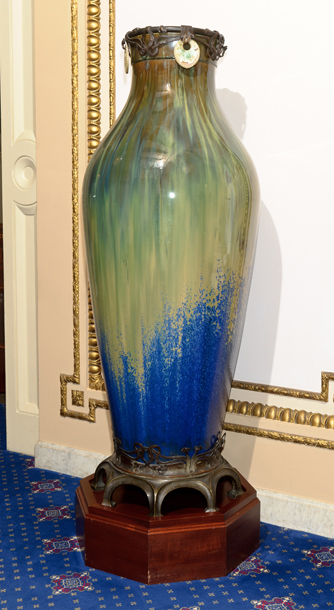
| Title | Sèvres Vase |
| Artist/Maker | National Porcelain Manufactory of Sèvres |
| Date | 1918 ca. |
| Medium | Porcelain, inlaid enamel, bronze |
| Dimensions | h. 68.75; diam. 28 in. (h. 174.6; diam. 71.1 cm) |
| Credit Line | U.S. Senate Collection |
| Accession Number | 46.00008.001 |
On September 24, 1918, French Ambassador Jules Jusserand (on behalf of the Republic of France) presented the U.S. Senate with two Sèvres vases as a token of "sisterly gratitude" for America's favorable reception of the Viviani-Joffre Mission and "timely help" in World War I.[1][2] The Senate Chamber was crowded for the ceremony, during which the "French Tricolor and the Stars and Stripes were displayed side by side" on the dais.[3] Vice President Thomas R. Marshall accepted the vases on behalf of the Senate and assured Ambassador Jusserand of America's "determination to fight with the French until justice [is served]."[4]
Standing nearly six feet tall, this vase is enveloped in a moss-green crystalline glaze on a blue ground and features a distinctive bronze platform-base and neck-rim that mimic leafy foliage and vine-like curves. Adorning the rim are four porcelain pendants. The brilliant colors and variegated patterns on the vase are the product of extreme heat and alchemy. When fired at high temperature, the thick glaze (composed of zinc oxide, ground quartz, and fused glass) flows down the vessel. Once the temperature is reduced, crystals form. The process contains so many variables that consistent or predictable results are almost impossible to obtain.
Some credit the Sèvres porcelain factory with developing the crystalline glazing process we know today. Founded in Vincennes in about 1740, and later reestablished in Sèvres near Versailles, France, the factory became the preeminent porcelain manufacturer in Europe in the second half of the 18th century. Early Sèvres pieces are characteristically decorated with extensive gilding, rich border designs, and elaborate figural scenes. With the advent of the Art Nouveau ("New Art") style at the end of the 19th century, Sèvres pieces took inspiration from organic forms of the natural world and were derived, in part, from botanical studies and illustrations of deep-sea organisms.
The Senate's vases (46.00008.001 and 46.00008.002) were briefly exhibited in the Senate Chamber for the acceptance ceremony and then moved to the Senate Chamber lobby, where they continue to be displayed today. A pair of similar vases was given to the House of Representatives, and can be seen in the Rayburn Room of the U.S. Capitol.
1. Following America's entry into World War I, the French mission—headed by M. Rene Viviani, Marshal Joffre, and Admiral Chocheprat—came to visit President Woodrow Wilson in 1917 to discuss how the United States could best help France in the war.
2. Proceedings in the Senate of the United States Upon the Occasion of the Presentation by Ambassador Jusserand, on Behalf of the Republic of France, of Two Vases From the National Manufacturer of Sèvres
(65th Cong., 2d sess., Washington, D.C.: Government Printing Office, 1918), 3
3. "Only Force Can Win, Says Jusserand,"
The New York Times, 25 September 1918.
4. Ibid